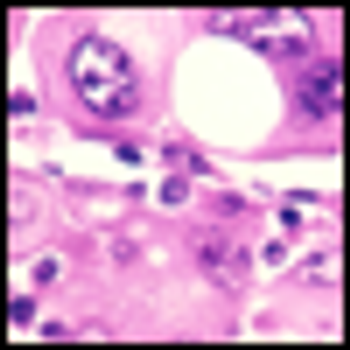
A blood test could soon be used to predict the risk of the spread of cancer among melanoma patients. The study identifying the potential test was published online on April 12th in Clinical Cancer Research, and AACR journal.

Your AI-Trained Oncology Knowledge Connection!



A blood test could soon be used to predict the risk of the spread of cancer among melanoma patients. The study identifying the potential test was published online on April 12th in Clinical Cancer Research, and AACR journal.

The US Food and Drug Administration (FDA) on March 25 approved ipilimumab (Yervoy, Bristol-Myers Squibb) as immunotherapy for patients with late-stage melanoma, based studies showing it improved survival outcomes in these difficult-to-treat patients.

For the first time, a series of metastatic melanoma (MM) patients have been genetically tested for the constitutively activating BRAF mutation and assessed for its prognostic significance as is routinely done for breast cancer (HER2) and chronic myeloid leukemia (ABL).

Patients with advanced melanoma now have access to the BRAF inhibitor PLX4032, which has shown survival advantages in a Phase III trial, as long as they have the "right" mutation. The drug's history so far is proving a case study on the challenges of developing personalized cancer treatment.

Researchers at the NCI reported today in Nature that interferon-gamma, a protein that had been thought to contribute to an innate defense system against cancer, may in some circumstances promote melanoma and incite the development of tumors.

The experimental injectible drug PV-10 turned in positive results in a phase II study in metastatic melanoma, according to Provectus Pharmaceuticals. An objective response (OR) was observed in 49% of the 80 subjects, with 71% of subjects achieving locoregional disease control in their injected lesions. A mean progression-free survival of 11.7 months was observed among subjects achieving an OR.

Each year, nearly 60,000 new cases of melanoma are reported in the United States. The vast majority of these are cured by surgery. However, 8,000 of these patients are found to have metastatic melanoma beyond the scope of surgical cure-and this number closely approximates the annual number of deaths from this disease. This statistic illustrates the lack of progress that had been made in the treatment of advanced melanoma over the last several decades.

Currently there are only three FDA-approved drugs available for the treatment of metastatic melanoma: dacarbazine, interleukin-2, and the lesser-used hydroxyurea. None of these drugs has been shown to improve overall survival (OS). The review by Thumar and Kluger provides a well-balanced overview of ipilimumab, the first agent to demonstrate a survival benefit in patients with metastatic melanoma.[1] The response to ipilimumab is most notable for its durability, a feature rarely observed in patients with high tumor burden or in response to other systemic therapies. However, a minority of patients (10% to 15%) treated with ipilimumab meet standard criteria for radiographic response. In this commentary, we focus on the question of how we can build on the success of ipilimumab. We briefly review one area of active investigation: the combination of ipilimumab with targeted inhibitors of BRAF.

Antibody-based targeting of the immune suppressor molecule cytotoxic T-lymphocyte antigen 4 (CTLA-4) with ipilimumab has been studied in metastatic melanoma in a number of clinical trials, including a recent phase III trial. This marks the first randomized clinical trial reporting an overall survival benefit using immune modulation in metastatic melanoma. Along with its therapeutic benefits, ipilimumab presents unique challenges to clinicians; these are related to the monitoring of treatment response and the management of drug-related toxicities. This drug is currently being investigated in various cancers, and its indications are likely to be expanded.

The authors provide a timely and relevant review of the role that the immune system plays in regulating tumor growth and how immune modulation can alter tumor response. This review follows from the recently published phase III trial of ipilimumab,[1] a monoclonal antibody to cytotoxic T-lymphocyte antigen 4 (CTLA-4) and the first therapy in several decades to produce prolonged overall survival (OS) in patients with metastatic melanoma. While this outcome underscores the importance of this therapy in treating metastatic melanoma, its clinical applicability, at least on a widespread level, necessitates further exploration.

Two cousins with cancer were randomized to different arms of a clinical trial of Roche’s melanoma drug, PLX4032. The implications were covered in a NYTs story, which questioned the ethical implications of our current trial design.

Ipilimumab has received FDA priority review status, according to Bristol-Myers Squibb. The review will focus on use of the drug in adult patients with previously treated advanced melanoma.

Like satellites tracking an invading force, a PET scanner at UCLA follows a battalion of tumor-seeking lymphocytes stalking melanoma tumors. Radioactive reporter genes, embedded in the lymphocytes, show the real-time location of these immune cells, genetically engineered to recognize antigens on the surface of the tumor cells.

A preclinical study provides the rationale for combining BRAF-targeted therapy with immunotherapy agents in patients with BRAF mutations. These mutations activate the MAPK signaling pathway, which leads to increased oncogenic potential. The researchers showed that in BRAF-mutant melanoma cell lines, a selective BRAF inhibitor (PLX4720) blocked the MAPK pathway and increased tumor antigen expression without affecting T-cell function.

Ipilimumab has being lauded as a monumental advance in the field of immuno-oncology. While the news is certainly promising, unanswered questions remain and the melanoma community must proceed with caution.

Ipilimumab, a monoclonal antibody against cytotoxic T-lymphocyte antigen 4 (CTLA-4), given alone or in combination with vaccine,w increased overall survival (OS) in patients with unresectable stage III/IV melanoma for whom previous treatment had failed, according to phase III trial results presented at the 44th annual meeting of ASCO (abstract 4). The double-blind randomized study evaluated ipilimumab and vaccine therapy with gp100 alone and in combination. Patients were assigned to receive ipilimumab (n = 137), ipilimumab and gp100 (n = 403), or gp100 alone (n = 136). Ipilimumab at a dosage of 3 mg/kg was given once every 3 weeks for four cycles, and gp100 was given at 1 mg every 3 weeks for four cycles. The primary endpoint was overall survival (OS). After 12 months, 46% of patients receiving ipilimumab alone, 44% receiving ipilimumab plus gp100, and 25% receiving gp100 were still alive. The hazard ratio (HR) for OS demonstrated a 32%–34% reduction in the risk for death in the two ipilimumab arms vs the gp100 arm alone (P = .0026 for ipilimumab alone vs gp100; P = .0004 for the combination vs gp100).

Conventional wisdom would have one believe that melanoma is a highly radioresistant tumor, perhaps even “radiation proof.” This reputation developed as a result of a combination of factors. First, early in vitro studies of melanoma radio-biology suggested that melanoma cells displayed enhanced postradiation survival vs comparison cells.[1] Second, clinical use of radiation therapy for melanoma did not seem to work very well.[2] This combination, a clinical observation supported by laboratory work, seems to have led radiation therapy to be avoided for melanoma treatment.

The case report by Magnuson and Halligan presents the palliative treatment of a patient with stage IV melanoma, distantly metastatic to several sites, including the lung, pulmonary vein, left atrium, and CNS. The article focuses on the external beam radiotherapy employed to treat the cardiac metastasis and includes a discussion of the role of radiotherapy in treating metastatic melanoma.

The successful treatment of a patient with primary nasal melanoma metastatic to the lung, pulmonary vein, and left atrium using radiation therapy is described. The patient was effectively treated with a conventional external beam radiation fractionation scheme (rather than a more commonly used hypofractioned regimen) that was utilized to minimize risk of arterial embolus of the tumor or rupture of a vessel wall. A post-treatment CT demonstrated a significant decrease in the caliber of the right pulmonary vein and tumor thrombus. The patient never developed cardiac valvular dysfunction or acute life-threatening massive embolism of tumor from the atrium. Unfortunately, the patient experienced clinical decline secondary to the massive progression of intra-abdominal disease and subsequently died from multiple liver metastases and liver failure. Numerous studies and this case report demonstrate that radiation therapy can be very effective in the treatment of malignant melanoma, especially when only small volumes of disease need to be treated and adequate total doses are used. Therefore, radiation therapy appears to play an important yet underutilized role in the treatment of metastatic melanomas.

The monoclonal antibody ipilimumab provides the first hopeful option ever for patients with metastatic melanoma. It has some peculiar qualities: Bad side effects are a good sign, and progression after treatment isn't necessarily a bad one.

Study pinpoints factors that put post-transplant patients at risk for non-melanoma skin cancers.

Concept and photographs:The Skin Cancer Foundation, www.skincancer.org

Prepared by The Skin Cancer Foundation, www.skincancer.org,and the American Academy of Dermatology

Skin cancer is the single most common form of cancer, accounting for more than 75% of all cancer diagnoses. More than 1 million cases of squamous cell and basal cell carcinomas are diagnosed annually, with a lifetime risk of more than one in five. The vast majority of skin cancers can be cured with surgery alone. Resection is the mainstay of therapy, even for skin cancer involving regional lymph nodes or, in some cases, more distant metastatic sites.

The imaging technique has the potential to measure the extent and depth of skin lesions.